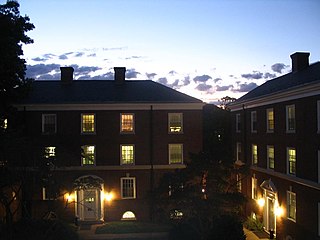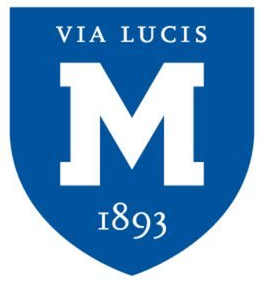
Goodwell is a town in Texas County, Oklahoma, United States. As of the 2020 census, the town’s population was 951. Goodwell is home to Oklahoma Panhandle State University.

Guymon is a city and county seat of Texas County, in the panhandle of Oklahoma, United States. As of the 2020 census, the city population was 12,965, an increase of 13.3% from 11,442 in 2010, and represents more than half of the population of the county, along with being the largest city in the Oklahoma Panhandle. Cattle feedlots, corporate pork farms, and natural gas production dominate its economy, with wind energy production and transmission recently diversifying landowners' farms. Guymon was the only town or city in Oklahoma in 2010 and 2020 in which the majority of the population was Hispanic.

Dwight Presbyterian Mission was one of the first American missions to the Native Americans. It was established near present-day Russellville, Arkansas in 1820 to serve the Arkansas Cherokees. After the Cherokee were required to move to Indian Territory in 1828, the mission was reestablished in 1829 near present-day Marble City, Oklahoma. The mission is listed on the National Register of Historic Places.
Oklahoma Panhandle State University (OPSU) is a public college in Goodwell, Oklahoma. OPSU is a baccalaureate degree-granting institution. General governance of the institution is provided by the Board of Regents of the Oklahoma Agricultural and Mechanical Colleges. Academic programs and financial support are authorized and coordinated through the Oklahoma State Regents for Higher Education.

Marycrest College Historic District is located on a bluff overlooking the West End of Davenport, Iowa, United States. The district encompasses the campus of Marycrest College, which was a small, private collegiate institution. The school became Teikyo Marycrest University and finally Marycrest International University after affiliating with a private educational consortium during the 1990s. The school closed in 2002 because of financial shortcomings. The campus has been listed on the Davenport Register of Historic Properties and on the National Register of Historic Places since 2004. At the time of its nomination, the historic district consisted of 13 resources, including six contributing buildings and five non-contributing buildings. Two of the buildings were already individually listed on the National Register.

Arkansas Tech University (ATU) is a public university in Russellville, Arkansas. The university offers programs at both baccalaureate and graduate levels in a range of fields. The Arkansas Tech University–Ozark Campus, a two-year satellite campus in the town of Ozark, primarily focuses on associate and certificate education.

Brown College at Monroe Hill is one of three residential colleges at the University of Virginia. Originally named Monroe Hill College, Brown opened in 1986 as the first modern residential college at the University of Virginia. It was renamed Brown College at Monroe Hill in recognition of the endowment donated by the Brown family in 1994. The college is led by James Coan, Principal, and John T. Casteen IV, Director of Studies. A number faculty fellows from many departments and schools of the university maintain close ties to the college.

Reinhardt University is a private university in Waleska, Georgia. The university has an off-campus center in Alpharetta and offers some programs in Cartersville, Marietta, and Canton, and online. Reinhardt is affiliated with the United Methodist Church.

North Yarmouth Academy is an independent, co-ed, college preparatory day school serving students from early childhood education to postgraduate. NYA was founded in 1814, in what was then North Yarmouth, Maine, prior to the 1849 secession that established Yarmouth, the town in which the school now stands. NYA has 375 enrolled students with an average class size of 14 students. NYA offers 16 interscholastic sports for boys and girls at the Varsity and Junior Varsity level.

Connecticut Hall is a Georgian building on the Old Campus of Yale University. Completed in 1752, it was originally a student dormitory, a function it retained for 200 years. Part of the first floor became home to the Yale College Dean's Office after 1905, and the full building was converted to departmental offices in the mid-twentieth century. It is currently used by the Department of Philosophy, and its third story contains a room for meetings of the Yale Faculty of Arts & Sciences, the academic faculty of Yale College and the Graduate School.

The Kentucky School for the Deaf (KSD), located in Danville, Kentucky, United States, is a school that provides education to deaf and hard-of-hearing children from elementary through high school levels. Founded in 1823, it was the first school for the deaf west of the Allegheny Mountains. Jacobs Hall, its oldest surviving building, was designated a National Historic Landmark in recognition of this history.

Mercersburg Academy is an independent selective college-preparatory boarding and day high school in Mercersburg, Pennsylvania, in the United States. Founded in 1893, the school enrolls approximately 444 students in grades 9–12, including postgraduates, on a campus about 90 miles northwest by north of Washington, D.C.

Olney Friends School is a small, co-educational boarding and day school affiliated with the Religious Society of Friends (Quakers). Located in the foothills of the Appalachian Mountains in Barnesville, Ohio, the school "challenges students to grow, celebrates intellectual vigor, provokes questions of conscience, and nurtures skills for living in community." Students come from around Ohio, around the country, and around the world to study the college prep curriculum. Currently (2017-2018), the school is attended by 53 students from 14 US states and 10 countries.

North Hall was the University of Wisconsin's first building. Built in 1851 in the woods and brush that would become Bascom Hill, this one building was the UW for its first four years, housing both dorm rooms and lecture halls. John Muir resided in North Hall when he was a student at the university from 1860 to 1863.

Martin Hall, also known as the George M. Bradley House is a historic house on the upper campus of Providence College.
The University of Arkansas Campus Historic District is a historic district that was listed on the National Register of Historic Places on September 23, 2009. The district covers the historic core of the University of Arkansas campus, including 25 buildings.

The Ohio State Normal College at Kent is a historic district in Kent, Ohio, United States. It consists of the five original buildings on the main campus of Kent State University, with the first, Merrill Hall, opening in 1913 and the last, Moulton Hall, opening in 1917. It was added to the National Register of Historic Places in 1975. The name of the district comes from the working name of what would later be named the Kent State Normal School in 1911 and ultimately Kent State University by 1935.

The History of Louisiana Tech University began when the Industrial Institute and College of Louisiana was founded in Ruston, Louisiana in 1894. The institute was founded to develop an industrial economy in the state of Louisiana. Four years later, the school was renamed the Louisiana Industrial Institute when Louisiana adopted the Constitution of 1898. When the Constitution of 1921 was passed, the school changed its name again to Louisiana Polytechnic Institute to reflect the school's evolution from a trade school into a larger and broader technical institute. Although the university was informally called Louisiana Tech for about five decades after the 1921 name change, it was not until 1970 when Louisiana Polytechnic Institute officially changed its name to Louisiana Tech University. Over the course of its history, the school grew from a small industrial institute with one building to a university with five colleges and an enrollment of around 11,800 students.

Fort Apache Historic Park is a tribal historic park of the White Mountain Apache, located at the former site of Fort Apache on the Fort Apache Indian Reservation. The park interprets the rich and troubled history of relations between the Apache and other Native American tribes at the fort, which was converted into a Bureau of Indian Affairs boarding school after its military use ended. The park, which covers 288 acres (117 ha) of the former fort and school, as well as a nearby military cemetery, form the National Historic Landmark Fort Apache and Theodore Roosevelt School historic district.



















